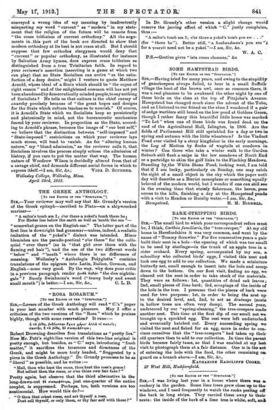BARK-STRIPPING BIRDS.
[TO THE EDITOR OF THE "SPECTATOR."]
Sin,—The small bird to which your correspondent refers must be, I think, Certhia familiaris, the "tree-creeper." At my old. borne in Herefordshire it was very common, and went by the name of " Tommy Scrawler." For five consecutive years a pair- built their nest in a hole—the opening of which was too smelt to be used by starlings—in the trunk of an apple tree in a cider orchard. Every spring, accompanied by my son, a schoolboy who collected birds' eggs, I visited this nest and took one egg to add to our collection. We made a miniature butterfly net, small enough to insert into the hole and scoop down to the bottom. On our first visit, finding no egg, we cleared out the nest in order to take stock of the materials. They were as follows: 1st, quantities of dried oak leaves ;. 2nd, small pieces of lime bark; 3rd, scrapings of the inside of the hole in the tree. I presume that the pieces of bark were used for two purposes: 1st, in order to bring the nest up to the desired level, and, 2nd, to act as drainage (neste- in hollow trees are often very damp). The second year-, undeterred by our "spring-cleaning," the tree-creepers made another nest. This time at the first dip of our small net we brought up a speckled egg. The rest were left undisturbed and -eventually hatched out. Every succeeding spring we visited the nest and fished for an egg, more in order to con- vince ourselves that the " tree-creepers " had taken up their old quarters than to add to our collection. In time the parent birds became fairly tame, so that I was enabled at my last visit to photograph them at a fair distance. One is in the set of entering the hole with the food, the other remaining oa guard on a branch above.—I am, Sir, &c., KA.THAIIINE RADCLIFFE COOKE.
27 West Hill, Huddersfield.










































 Previous page
Previous page